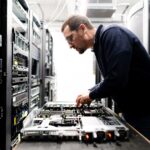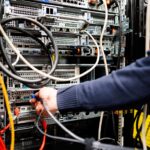While it might be tempting to focus all of our attention on the latest upheavals of the current market, IT leaders know that it pays to keep an eye on the future.
An awareness of the direction in which things are going is especially valuable in the fast-moving world of tech, where knowledge about future trends makes it possible to have a larger-picture perspective of how each tactical move fits into the general framework of the path we’re on.
For this reason, we have assembled a list of the major IT trends that are expected to gain increasing importance in the near-future and how they’re expected to impact companies at large.
Artificial Intelligence
Google CEO Sundar Pichai described AI as “more profound than electricity or fire”, and the exponential improvements of artificial-intelligence powered applications point towards a future where this technology is everywhere.
While by now it’s no secret that integrating AI into a company’s operations is expected to result in great productivity increases in the coming years, two aspects of this technology are being singled out as playing a crucial role in its adoption and success: AI TRiSM and adaptive AI.
- AI TRiSM
The growing complexity of AI needs to include measures that ensure governance, trustworthiness, fairness, reliability, efficacy and privacy. The category of tools and processes that makes this possible, known as AI TRiSM (for Trust, Risk & Security Management) makes AI models easier to interpret and explain.
According to Gartner, by 2026, companies that operationalize TRiSM will see AI models achieve 50% result improvement in terms of adoption, business goals and user acceptance.
- Adaptive AI
Adaptive AI makes it possible for models to self-adapt and change after having been deployed through real-time feedback. Gartner’s prediction is that by 2026 companies that adopt AI engineering practices to build and manage adaptive AI systems will outperform competitors by at least 25% in operationalizing AI models.
Hyperautomation
By now, the expected benefits of increasing automation are known — they include driving efficiencies and freeing up workers for skilled tasks. This has led to the pursuit of hyperautomation, the process of identifying, vetting and automating as many processes as possible.
The promise of hyperautomation is that it will streamline and speed up the ability to extend automated processes across the company. With solutions based on machine learning and artificial intelligence, hyperautomation is expected to enable intelligent tech to partner with human counterparts at work.
Cloud Services
The adoption of cloud software, platform and infrastructure services will continue as companies seek the flexibility, speed and competitive costs of these services. Specifically, industry-specific platforms that specialize in meeting the needs of a given sector are one of the fastest growing trends in cloud computing services.
This fits in with the over-arching IT trend of customization, in which enterprises increasingly demand specialized solutions that cater to the specific needs of their segment or can be adapted to their preferred workflow.
The Metaverse
While the metaverse remains a nebulous concept for many, it is predicted to develop at a rapid pace and become a major force in the coming years. As a combination of different innovations rather than just a single technology, the end result is a virtual environment that transforms or extends physical reality and is expected to drive employee collaboration and engagement within companies.
While still a nascent phenomenon, by 2027 over 40% of large corporations are expected to be using metaverse-based technology.
Sustainable Tech
The importance of sustainable technology keeps growing, and has in fact become a top priority for many leaders and CIOs.
Understood as a framework of solutions that enable the sustainability of both companies and their clients, sustainable tech is the lens through which every other trend and technology is being appraised. In fact, one of the main selling points of technologies such as AI, automation and shared cloud services is the way in which they can help reduce the environmental impact of IT services as well as make it easier to track sustainability goals.
While it’s already impossible to ignore this trend, 50% of CIOs are expected to have performance metrics that track the sustainability of their IT operations by 2025.
One of the smartest ways in which IT leaders can improve the sustainability of their operations is by extending the life of their existing hardware, which has the added virtue of helping to maximize the ROI of the equipment. By breaking free of maintenance agreements with the original manufacturers and moving to third-party maintenance solutions, enterprises can prevent the manufacture of new equipment and give new life to their hardware with refurbished parts. The upshot, besides the savings realized by the reduced expense, is a smaller carbon footprint due to the prevented emissions and related e-waste.
Sources:
Gartner’s Top 10 Strategic Tech Trends For 2023
https://www.forbes.com/sites/peterhigh/2022/10/19/gartners-top-10-strategic-tech-trends-for-2023/?sh=46f7c5944cb4
The 5 Biggest Technology Trends In 2023 Everyone Must Get Ready For Now
https://www.forbes.com/sites/bernardmarr/2022/09/26/the-5-biggest-technology-trends-in-2023-everyone-must-get-ready-for-now/?sh=1648dbbc55d9




